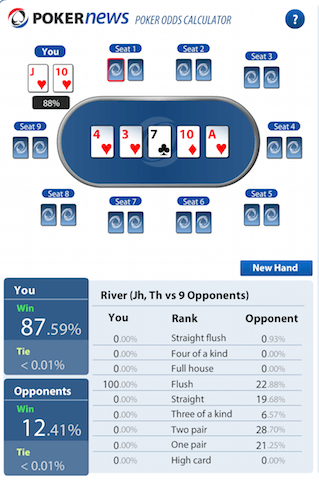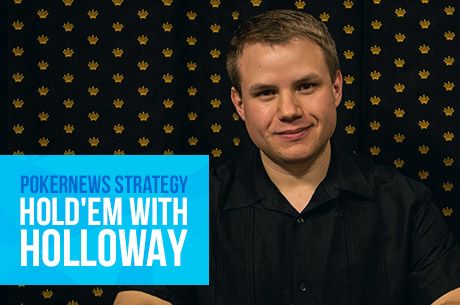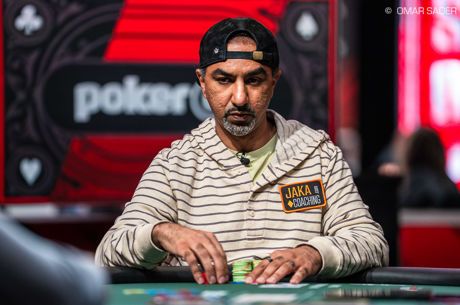Hold��em with Holloway, Vol. 15: Navigating Multiple Decision Points in a Poker Hand

I like putting people to the test. In tournament poker, I do this by betting and raising frequently. What I don��t like is when I��m flummoxed by my own hand. Many decisions in poker are straightforward. Wake up with a big hand in position �� raise. Look down at deuce-seven offsuit with a four-bet in front of you �C fold. Look down at the J?10? in the big blind after four players limped �� well, this is when things get a little more complex.
That was the exact situation I faced in a recent $60 buy-in Thursday night tournament at my local casino. We started with 12,000 in chips, and it was near the end of Level 1 with the blinds at 25/50. After playing the hand the way I did, I couldn��t help but think things could have played out differently. It stuck with me long after the tournament, so I��ve decided to examine the hand in more detail.
Preflop
It��s important to remember the level of competition in this particular tournament. It was a cheap nightly, meaning it was chock full of amateurs and first-timers. Sure, there were some decent locals, but overall the quality of play was poor. Players wanted to have fun, see flops, and gamble it up.
With that in mind, I wasn��t surprised to see four players limp. In fact, oftentimes limping is the order of the day in these sort of tournaments. Like I said, amateurs want to see flops. Given its potential, I like hands such as Jx10x-suited. I raise with them often, but in this hand I felt my best option was to check and see a free flop.
I could have raised to something like 250, but with such deep stacks, I��m sure at least three of the four limpers would come along. Like I said, these players like to see flops. I didn��t see the point of building a pot out of position with a speculative hand. Besides, if I flopped big, I wanted as many players in the hand as possible.
I��m content with checking my option to see the flop.
Flop
The 4?3?7? flop was halfway decent. I picked up a flush draw to go with my two overs, but more importantly I was in the big blind, meaning low cards were well within my range. Still, I checked as did the next two players. The player in the cutoff then bet 300, the button called, and action was back on me.
My first impression was to put in a raise. I was in a great position to represent a made hand, and if I received a call I had a strong draw to fall back on. If I was three-bet, well it��d be easy enough to get away.
I really like a raise to 1,100 or so in this spot, but for whatever reason I played it passively and just called. I��m not really sure what I was thinking, but in hindsight I suppose it was something like, ��I��m out of position and it��s cheap to see if I make my flush.�� Understandable, but by taking that line I tossed out any fold equity I may have had and allowed my opponents an opportunity to realize their own equity.
Definitely not happy with my play here.
Turn
The 10? turn was great for my hand. I now held top pair with a flush redraw, and it was well disguised. I checked figuring one of my two opponents would bet, and sure enough the cutoff continued for 700. The button called once again, and it was time to take control of the hand.
I settled on making it 2,000 more to go, which was about two-thirds of the 3,250 pot. If I were playing in either a World Series of Poker or World Poker Tour event against more experienced players, I��d have been a little concerned about the button��s flat-calls, but in a nightly I figured it was more likely he held either a weak, one-pair hand or a mediocre draw. Whatever the case, I knew my raise would sift through the riffraff.
The cutoff called, which led me to believe he held a big pocket pair. Aside from the preflop limp, he had represented strength on both postflop streets, so jacks through aces made sense. Plus, a call in this spot was consistent with such a hand. He��d be hard-pressed to reraise for fear of a set or flopped straight. If I were in his shoes with a big pocket pair, I��d be looking to get to showdown as cheaply as possible.
The button then tossed his hand, and that made it heads-up action to the A? river.
River
The third heart gave me a flush, and I knew a bet was in order. I should have been confident with my flush �� there were only two higher flushes that beat me �� but loss aversion struck me. Is it possible he has a better flush than me? Did he just call hoping to fill a king-high flush draw?

These questions paralyzed me, but still I knew I had to bet something. Thinking about the hand now, I wish I��d have bet somewhere near the size of the pot (7,250). By doing so I would have put my opponent to a polarized decision �� does he have the flush or not? If he had a bigger flush, then I was probably going to lose a big pot anyway. If he had a big pocket pair, he��d have a difficult decision to make, though the ace on the river could very well scare off jacks, queens, and kings.
I guess that��s what I was thinking as I eventually bet a modest 2,500, just over a third of the pot. I��d like to say I was betting for value, but in reality it��s just what I tossed out because I knew I had to bet something. I immediately knew it was a mistake as I gave him a golden opportunity to put me to the test. If he moved all in, I��d have been in a tight spot. With the ace on the river, I��d have assumed that he wouldn��t raise with a big pocket pair, meaning he could very well have a flush. The question then would be whether or not it was bigger than mine.
It��s best to avoid such difficult decisions, but here I gave him the opportunity to turn it back on me. If I was playing against a higher level of competition, I could very well have been blown off this hand. Fortunately, my opponent just called after a brief spell in the tank, which signaled my flush was best.
I tabled the J?10? and my opponent shook his head in disgust. He then showed A?A? for a rivered set. I was happy to win the hand, but I wasn��t entirely content with how I��d played it. I��m fine with my preflop and turn choices, but not so much with my flop and river play. There��s no doubt I should have been more aggressive on the former street, and there seemed to be better options on the latter. Had I followed through with a big bet on the river, I probably would have won more chips (my opponent didn��t strike me as the type to lay down trip aces), but then again would he pay me off with anything else?
In the grand scheme of the tournament, this particular hand amounted to little (I failed to cash). But it shows that while some hands play out on autopilot, others are filled with multiple decision points. The best players in the world know how to navigate these junctures with little thought, but for the rest of us it��s important to think through all possible options. Which route, be it easy or rocky, will lead to you winning the hand for as most value as possible?
Have criticisms of how I played the hand? How would you have played it? Let me know on Twitter @ChadAHolloway and we can talk about it.
Get all the latest PokerNews updates on your social media outlets. Follow us on Twitter and find us on both Facebook and Google+!
In this Series
- 1 Hold��em with Holloway, Vol. 1: Making Reads and Trusting Them
- 2 Hold��em with Holloway, Vol. 2: Playing in Poker Charity Events
- 3 Hold��em with Holloway, Vol. 3: Throttle Back Before You End Up Punting
- 4 Hold��em with Holloway, Vol. 4: Punish the Satellite Bubble
- 5 Hold��em with Holloway, Vol. 5: What is Proper Accumulator Strategy?
- 6 Hold��em with Holloway, Vol. 6: A Chip and a Chair Story with ��SirWatts��
- 7 Hold��em with Holloway, Vol. 7: 15 Things About Poker I Wish I��d Known Sooner
- 8 Hold��em with Holloway, Vol. 8: Examining the Largest Overlay in Poker History
- 9 Hold��em with Holloway, Vol. 9: Differences Between Rebuys and Reentries
- 10 Hold��em with Holloway, Vol. 10: Five Must-Read Poker Books of 2014
- 11 Hold��em with Holloway, Vol. 11: When Will You Finally Break Through?
- 12 Hold��em with Holloway, Vol. 12: Dealing with a Target on Your Back
- 13 Hold��em with Holloway, Vol. 13: Knowing When to Call It Quits
- 14 Hold��em with Holloway, Vol. 14: Embarking on a Year-Long Weight Loss Journey
- 15 Hold��em with Holloway, Vol. 15: Navigating Multiple Decision Points in a Poker Hand
- 16 Hold��em with Holloway, Vol. 16: Chris Moorman Tells Me How Badly I Play Poker
- 17 Hold��em with Holloway, Vol. 17: Richard ��nutsinho�� Lyndaker on Getting It in Marginal
- 18 Hold��em with Holloway, Vol. 18: Getting Inside the Head of Poker Pro Brian Rast
- 19 Hold��em with Holloway, Vol. 19: Stupid Calls & Lucky Draws in MSPT WI Championship
- 20 Hold��em with Holloway, Vol. 20: Talking Ante-Only Strategy with Greg ��FossilMan�� Raymer
- 21 Hold��em with Holloway, Vol. 21: Contributing to Jonathan Little��s New Book
- 22 Hold��em with Holloway, Vol. 22: Consequences of Acting Out of Turn & Tossing in Chips
- 23 Hold��em with Holloway, Vol. 23: When It Comes to Chops, Do What��s In Your Best Interest
- 24 Hold��em with Holloway, Vol. 24: Accepting Bad Beats & Lessons in Selling Action
- 25 Hold��em with Holloway, Vol. 25: Heinz�� Ace-High Call Shows Why He's a World Champ
- 26 Hold��em with Holloway, Vol. 26: Is Keeping the Short Stack Alive Collusion?
- 27 Hold��em with Holloway, Vol. 27: Great Laydown or Bad Fold on Poker Night in America?
- 28 Hold��em with Holloway, Vol. 28: Calling Hellmuth with Jack-Deuce Offsuit
- 29 Hold��em with Holloway, Vol. 29: The Philosophy of "No-Chop" Chad
- 30 Hold��em with Holloway, Vol. 30: Preparing to Play the World Series of Poker
- 31 Hold��em with Holloway, Vol. 31: Staying on Your Grind at the World Series of Poker
- 32 Hold��em with Holloway, Vol. 32: The Perilous Decision to Call Off with Ace-Queen
- 33 Hold��em with Holloway, Vol. 33: Using Poker Skills in Reality TV Competitions
- 34 Hold��em with Holloway, Vol. 34: Esfandiari Explains How to Recover from Bad Beats
- 35 Hold��em with Holloway, Vol. 35: Tilly vs. Brunson in Super High Roller Cash Game Hand
- 36 Hold��em with Holloway, Vol 36: Unconventional Play Leads to Good WSOP Main Event Start
- 37 Hold��em with Holloway, Vol. 37: Lessons in Pot-Limit Omaha Hi-Low w/ Evan Jarvis
- 38 Hold��em with Holloway, Vol. 38: Things to Say and Do When You Bust a Poker Tournament
- 39 Hold��em with Holloway, Vol. 39: How Much Did I Have to Raise to Get You to Fold?
- 40 Hold��em with Holloway, Vol. 40: Practicing Patience in My Deep PPC Poker Tour Run
- 41 Hold��em with Holloway, Vol. 41: Analyzing a Questionable SHRPO Main Event Hand
- 42 Hold��em with Holloway, Vol. 42: Analyzing the Play of Neymar Jr. at EPT Barcelona
- 43 Hold��em with Holloway, Vol. 43: The Value of a Reliable Poker Reputation
- 44 Hold��em with Holloway, Vol. 44: John ��KasinoKrime�� Beauprez Rips My PLO Game Apart
- 45 Hold��em with Holloway, Vol. 45: Satellite Dilemmas -- To Call or Not to Call
- 46 Hold��em with Holloway, Vol. 46: Seiver Leverages the River in Super High Roller Bowl
- 47 Hold��em with Holloway, Vol. 47: What Untraditional Moves in Poker Might Mean
- 48 Hold��em with Holloway, Vol. 48: Thinking About the Future with Sam Grizzle
- 49 Hold��em with Holloway, Vol. 49: WCOOP Champ ��Coenaldinho7�� Offers Up His Biggest Hands
- 50 Hold��em with Holloway, Vol. 50: The Peril of Shoving Weak Aces
- 51 Hold��em with Holloway, Vol. 51: The Importance of Not Giving Up in Poker Tournaments
- 52 Hold��em with Holloway, Vol. 52: Does Asking ��Check�� Actually Constitute a Check?
- 53 Hold��em with Holloway, Vol. 53: Thomas Cannuli Impresses Even After Main Event Bustout
- 54 Hold��em with Holloway, Vol. 54: Dealers Aren��t Always Right
- 55 Hold��em with Holloway, Vol. 55: Don��t Get Married to Pocket Aces
- 56 Hold��em with Holloway, Vol. 56: Bazeley��s Survival Instinct Leads to Continued Success
- 57 Hold��em with Holloway, Vol. 57: Playing ��Deuces Wild�� on the European Poker Tour
- 58 Hold��em with Holloway, Vol. 58: The Wildest Hand in European Poker Tour History
- 59 Hold��em with Holloway, Vol. 59: Death, Zombies & Spending Time w/Phil Hellmuth
- 60 Hold��em with Holloway, Vol. 60: How the Unstoppable Fedor Holz Managed to Win Again
- 61 Hold��em with Holloway, Vol. 61: Lessons To Be Learned When You Hit the Big Stage
- 62 Hold��em with Holloway, Vol. 62: Steve O��Dwyer Explains the ��Oreo Cookie Tell��
- 63 Hold��em with Holloway, Vol. 63: What Would Happen to a Chip Stack If a November Niner Died?
- 64 Hold��em with Holloway, Vol. 64: Forgetting One Chip -- Should It Still Be an All-In Bet?
- 65 Hold��em with Holloway, Vol. 65: Todd ��sharkslayerrr�� Breyfogle on Bankroll Management
- 66 Hold��em with Holloway, Vol. 66: Cash Game Pro Daniel Arfin Offers Sound Bankroll Advice
- 67 Hold��em with Holloway, Vol. 67: Honeyman Plays Kings to Keep in Opponent��s Bluff Range
- 68 Hold��em with Holloway, Vol. 68: Why Do I Even Bother Drinking at the Poker Table?
- 69 Hold��em with Holloway, Vol. 69: Is Your Favorite Poker Pro Left- or Right-Handed?
- 70 Hold��em with Holloway, Vol. 70: In Order to Live You Have to Be Willing to Die
- 71 Hold��em with Holloway, Vol. 71: How to Amass a Big Stack Early in a Poker Tournament
- 72 Hold��em with Holloway, Vol. 72: Answering User-Submitted Poker Scenarios
- 73 Hold��em with Holloway, Vol. 73: Saying Goodbye with a Top Five List
- 74 Hold'em with Holloway, Vol. 74: We're Back, Baby!
- 75 Hold'em with Holloway, Vol. 75: Jivkov on Exploiting Capped Ranges
- 76 Hold��em with Holloway, Vol. 76: Matt Bretzfield Gets Tricky With Aces
- 77 Hold'em with Holloway, Vol. 77: Joseph Cheong Gets Crazy with a Pair of Ladies
- 78 Hold'em with Holloway, Vol. 78: Wyoming Poker Action & Wild South Dakota Hand
- 79 Hold'em with Holloway, Vol. 79: Calling Controversy at WinStar
- 80 Hold'em with Holloway, Vol. 80: Going for Value with Matt Hunt
- 81 Hold'em with Holloway, Vol. 81: Bracelet Winner Ryan Leng on Bad Call
- 82 Hold'em with Holloway, Vol. 82: Romeopro33 Recounts XL Eclipse Victory
- 83 Hold'em with Holloway, Vol. 83: Men The Master Doesn't Get Paid
- 84 Hold'em with Holloway, Vol. 84: Harman Hits Back-to-Back Miracle Turns
- 85 Hold'em with Holloway, Vol. 85: Jamie Kerstetter on Dealing with Bounties
- 86 Hold'em with Holloway, Vol. 86: Matt Stout Develops a Limp Dynamic
- 87 Hold'em with Holloway, Vol. 87: Matt Alexander Caught in Between w/ Two Red Aces
- 88 Hold'em with Holloway, Vol. 88: John Beauprez on Why He Folded a Set of Jacks
- 89 Hold'em with Holloway, Vol. 89: Alex Aqel Lets Opponent Hang Himself with Aces
- 90 Hold'em with Holloway, Vol. 90: David Peters Makes Beastly Call Against Will Givens
- 91 Hold'em with Holloway, Vol. 91: Poker Lessons from a Game of Risk
- 92 Hold'em with Holloway, Vol. 92: My Upstuck Diagnosis by the CLC Squad
- 93 Hold'em with Holloway, Vol. 93: Alex Foxen Coolers Nick Petrangelo in SHRB
- 94 Hold'em with Holloway, Vol. 94: My $25,000 PSPC Experience at 2019 PCA
- 95 Hold'em with Holloway, Vol. 95: The Equity of Leveraging Time Extensions
- 96 Hold'em with Holloway, Vol. 96: Dan O'Brien on Developing Healthy Routines
- 97 Hold'em with Holloway, Vol. 97: Big Hands From the WSOP-C Potawatomi
- 98 Hold'em with Holloway, Vol. 98: Simon Deadman Rips Apart My NLH Tourney Play
- 99 Hold'em with Holloway, Vol. 99: Shoving 10-6 Smack Dab Into Pocket Aces
- 100 Hold'em with Holloway, Vol. 100: The Revived Re-Entries Debate








